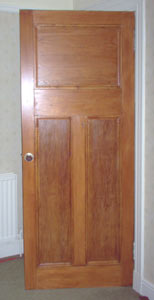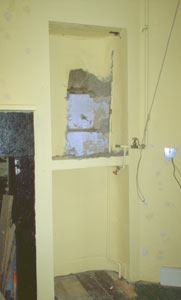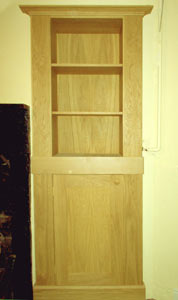
Restoration and repairs
I started on the slippery slope of furniture making and general building with domestic diy, along the way picking up some practical knowledge about period properties and how to restore them (indeed, I have just finished Glasgow University's continuing education course for architects, called looking after older properties). My first paid job was sanding a friend's floor, and we continue to sand floors today, offering a finish in shellac & danish oil as well as the conventional polyurethene or acrylic varnishes.
Working with antiques has given me plenty of experience at refinishing wood coated in Victorian and Edwardian shellac/french polish. This has been put to good use in restoring the finish to architectural woodwork: doors, skirtings, staircases and panelling. To my amazement, I have found that most painters and decorators do not know what to do with old shellac, so long has it been out of fashion. Indeed, being out of fashion means that french polishers are rapidly becoming scarce. Restoration is often a fairly quick and painless process, with no need for caustic stripping chemicals.
For no good reason that I can think of, we have not advertised that we repair and restore antiques. A few of our customers have asked us to undertake some repairs and we have amazed even ourselves at how well and cheaply we can make things good as old. Admittedly, we are particularly good now that we have a guitar maker working alongside us. He specialises in repairing guitars and has transferred that skill to furniture.
The last year has seen us repairing quite a few windows. This has proven to be most successful when the customer can get the windows in and out themselves or with help from another. We just don't ever seem to have the time to get out to your home to do small joinerish jobs.  But I should mention that doors are a speciality. Indeed, we have rebuilt dozens of doors for other businesses (paint stripping businesses, primarily). Many a home has had their old panelled door butchered to insert some hideous piece of glass in the past. We take the glass out and restore the timber rails and panels. This door pictured left came to us as no more than an original frame (painted white) with the entire centre filled with glass. We matched the original pitch pine with some pitch pine and some Douglas fir, then refinished it as it would originally have been in shellac. Although this may not seem the cheapest way to get a "new" door, doors from salvage yards are never quite the right size and therefore need to be built up or cut down slightly. The hinge rebate is never in the right place, so fitting is not straightforward. Once we've rebuilt your door, however, it is still the same old door, so it is the right size and goes back into place easily. The time and money saved not having to find a salvaged door and resize and rehang and then refinished it makes our restoration the cheaper method.
But I should mention that doors are a speciality. Indeed, we have rebuilt dozens of doors for other businesses (paint stripping businesses, primarily). Many a home has had their old panelled door butchered to insert some hideous piece of glass in the past. We take the glass out and restore the timber rails and panels. This door pictured left came to us as no more than an original frame (painted white) with the entire centre filled with glass. We matched the original pitch pine with some pitch pine and some Douglas fir, then refinished it as it would originally have been in shellac. Although this may not seem the cheapest way to get a "new" door, doors from salvage yards are never quite the right size and therefore need to be built up or cut down slightly. The hinge rebate is never in the right place, so fitting is not straightforward. Once we've rebuilt your door, however, it is still the same old door, so it is the right size and goes back into place easily. The time and money saved not having to find a salvaged door and resize and rehang and then refinished it makes our restoration the cheaper method.
Elsewhere on the website you will find cupboards that we build to fit into the old press (built in cupboard) in, primarily, sitting rooms. But the same can be done anywhere in a property. Here is a before and after in a tenement flat.


